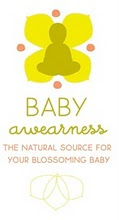
You’ve heard and read about the great benefits of babywearing, such as babies cry less, a “hands-free” way to hold your baby while you do housework and easy, discreet on-the-go nursing. Now, how do you choose the right carrier for you?
Here are some key features of carriers you can find at Baby aWEARness:
Stretchy wraps like the
Moby Wrap, allow you to carry your baby securely and close to you, while remaining hands-free. You can discreetly nurse your baby in a Moby Wrap. Later, you can use your Moby wrap to hold baby forward-facing. Moby Wraps can even hold twins! The Moby Wrap is the least expensive of the carriers and are excellent for newborn – middle infancy.
Ring Slings like the
Rockin Baby Sling are great for parents who want something easy to take on and off and stuff in their diaper bag when not in use. Ring slings are excellent for nursing discreetly and on-the-go. Ring slings can hold your baby upright, cradle hold (semi-upright), forward-facing, on your hip and back carry. These carriers are often less hot for the wearer since there is less fabric touching your body. The Rockin Baby Sling is reversible and features two pockets for carrying your wallet, an extra diaper or toys and available in organic fabric.

Mei Tai carriers like the
BabyHawk and
Freehand Baby Carrier allow you to carry your baby from newborn through toddlerhood. These are great carriers for mom and dad to share when there is a big difference in height or body shape since you don’t have to adjust buckles and clasps each time there is a different wearer. Mei Tai carriers are fairly lightweight and easy to store in a diaper bag when not in use. They allow you to do hands-free front and back carry and work well for hiking and long carries.
Soft structured carriers like the Beco,
Ergo, Lillebaby,
Angelpack and Pikkolo are easy to use, hands-free carriers, especially good for hiking and long carries. The Beco, Ergo and Lillebaby can be used newborn – toddlerhood. Some may require an infant insert to be purchased. The Lillebaby and Pikkolo allow you to do a forward-facing carry with your baby. The Angelpack is nice for taller parents or taller babies because if its longer design. All of these brands can do front and back carry and feature a hood that you can use to shield baby from the sun or for more privacy when your baby falls asleep. Some are available in organic fabrics.
Another tip: plan on trying on a few different carriers to see which one feels best on your body and your baby seems happiest in. This is the best way to ensure that you’re picking out the right carrier that you’ll want to use all the time.
A Word About Slings and Babywearing Safety
You may have seen some negative stories about slings recently in the news. The type of slings in question are the "bag" slings that are large, worn low on the parent's body and have little to no adjustability. Baby aWEARness does not sell this type of sling. Many carriers are very safe, however any carrier (including carseats and strollers) can pose a threat to a baby when used incorrectly, so here are some safety tips to help you wear your baby safely:
- Wear your baby high and snug on your chest. You should be able to reach down and give her a kiss.
- Make sure baby's chin is not pressed against his chest.
- Baby's face should be uncovered at all times.
- In a pouch or ring sling, baby's bottom should always be lower than his knees.
- Make sure baby's back and head are supported so that she is not curled up like a "C".
If you need some help or a unsure of how to position your baby in your carrier, help is available.
We hold
Babywearing 101, the second Saturday of every month where you can get expert adive on carriers. Baby aWEARness employees are also available to help you with your carrier.




















 />
/>